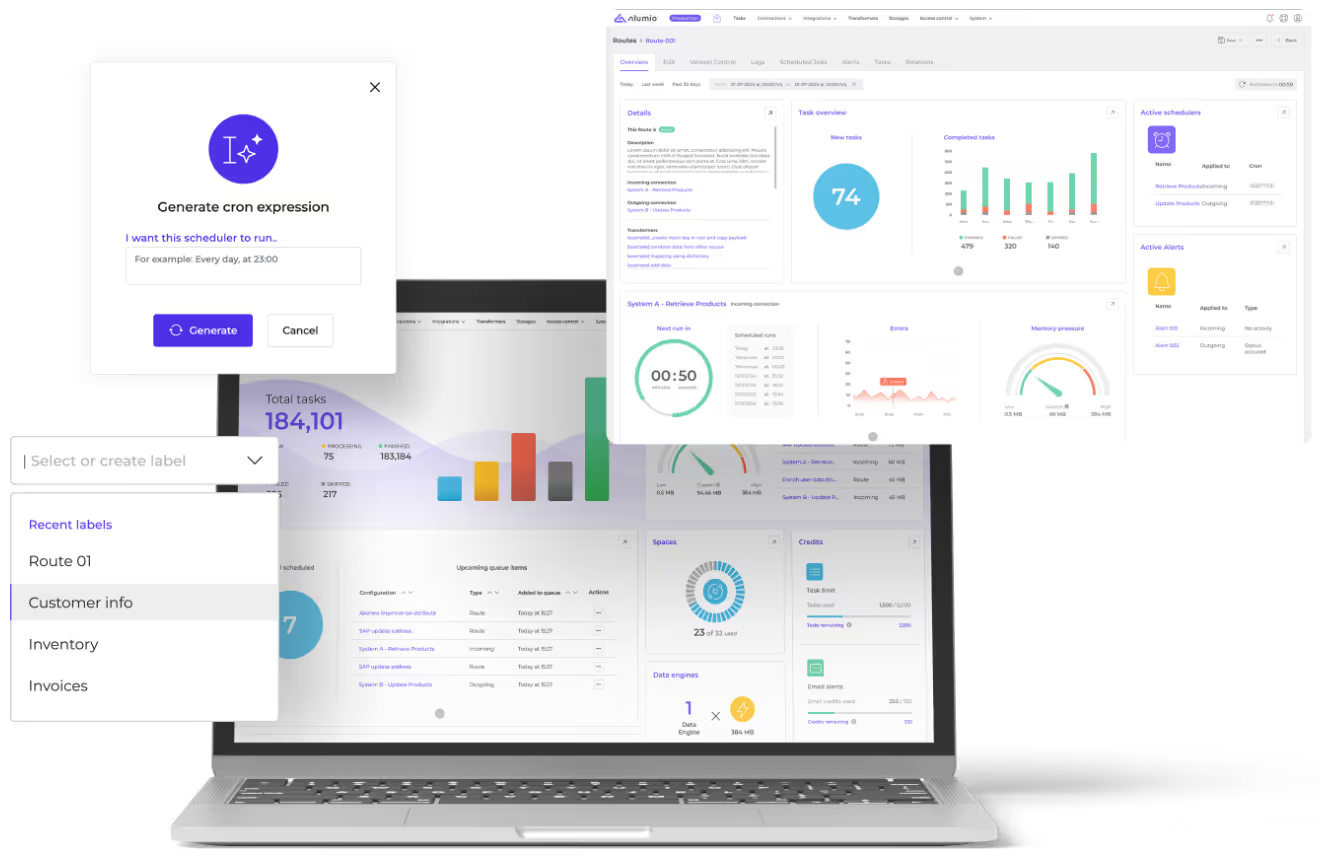What is composability in manufacturing?
Composability in manufacturing is about building a flexible, modular digital ecosystem that adapts to evolving business needs. Traditional manufacturing IT landscapes are often built on rigid, monolithic systems, where every function is tightly interwoven, making even small changes costly and disruptive. This lack of agility slows innovation and creates bottlenecks in responding to market shifts, supply chain disruptions, or new production requirements.
A composable approach solves this by allowing manufacturers to assemble their digital architecture from interchangeable, best-of-breed components. Instead of being locked into a single, all-in-one system that may not fully align with their operations, manufacturers can select the most effective tools for ERP, PIM, CRM, or e-commerce. They can integrate specialized solutions for key functions like inventory management, predictive maintenance, or order processing without overhauling their entire infrastructure.
Challenges manufacturers face when transitioning to a composable architecture
Resistance to change
One of the biggest hurdles in transitioning to a composable approach isn’t technology; it’s mindset. Adopting composable architecture requires more than just upgrading systems; it demands a fundamental shift in how manufacturers think about workflows, training, and business continuity.
Many manufacturers have relied on legacy systems and ingrained processes for years, sometimes decades. The idea of dismantling a system that has been the backbone of operations isn’t just daunting—it feels like a risk too big to take, especially when faced with the familiar “if it ain’t broke, don’t fix it” mentality.”
Remco Molenaar
Owner, Miller Digital
Unlike industries such as finance and retail, which have rapidly embraced digital transformation, manufacturing has traditionally been slower to adapt. This hesitation stems in part from the complexity of its technology. However, clinging to outdated systems can hinder innovation, limit scalability, and create long-term inefficiencies.
Therefore, team education and structured training are critical to ensuring a smooth and controlled transformation. By equipping employees with the right knowledge and skills, manufacturers can mitigate risks, foster confidence in new technologies, and create a culture that embraces adaptability rather than resists it.
Outdated technology and monolithic setups
Another major hurdle in transitioning to a composable approach is system integration. Many legacy ERPs, PIMs, and CRMs were not designed for open APIs or real-time data exchange. Instead, they rely on outdated processes like batch data transfers, file-based exchanges, and rigid data structures, making integration with modern cloud applications both costly and time-consuming.
Composable architecture, by contrast, thrives on seamless interoperability and real-time data flow. Live inventory updates, automated order processing, and predictive maintenance alerts all depend on instant, bi-directional communication between systems. Without proper integration, manufacturers risk bottlenecks, inefficiencies, and lost opportunities for automation.
Additionally, legacy systems often store and structure data differently, leading to inconsistencies when syncing product, order, or customer data across applications. Many manufacturers have also spent years customizing their ERP or CRM to fit highly specific workflows. While these modifications may have worked in a monolithic setup, they don’t always translate seamlessly into a modular environment, often requiring extensive rework or leading to technical debt that hinders long-term agility.
Potential downtime and revenue loss
When it comes to switching to a composable setup, full system replacement isn’t just impractical; it’s a major risk. Manufacturing systems are mission-critical, and downtime is simply not an option. Any disruption to core systems like ERP or warehousing can bring production to a standstill, leading to significant revenue loss.
Unlike wholesalers, who can continue selling existing stock if a system goes down, manufacturers rely on a continuous production flow. Even a few days of downtime can have catastrophic consequences, from delayed orders and supply chain disruptions to lost contracts and damaged customer trust.
This is why a gradual, phased approach to digital transformation is essential. By integrating composable solutions step by step, rather than replacing entire systems all at once, manufacturers can modernize their operations while maintaining business continuity and minimizing risk.
Solving manufacturing challenges through composability
A sustainable bottom-up strategy that drives innovation
Composability fosters a bottom-up approach to innovation, an essential advantage in complex supply chains. Traditional top-down strategies often fail in manufacturing environments because no two operations, workstations, or teams function exactly the same. Each station has a distinct role, and every operator brings specialized skills and insights that contribute to overall efficiency.
As such, forcing a one-size-fits-all solution onto such a dynamic ecosystem usually backfires. Top-down approaches tend to overlook the nuances that keep production running smoothly, leading to inefficiencies and resistance to change.
With a composable approach, innovation happens at the source. Those closest to an operational challenge, whether on the shop floor, in logistics, or in demand planning, can implement targeted solutions in real time rather than waiting for rigid, top-down directives. This empowers teams to solve problems proactively, optimize workflows, and drive continuous improvement without disrupting the entire system.
Real-time decision-making through data synchronization
One of the biggest advantages of composability is its ability to eliminate persistent data silos. In many manufacturing environments, sales, production, supply chain, and inventory systems operate in isolation, slowing down decision-making and reducing overall efficiency. Outdated reporting methods, such as batch updates or manual reports, add to the problem, leaving manufacturers without real-time insights and putting them at a competitive disadvantage.
By leveraging an integration platform like iPaaS, manufacturers can seamlessly connect their composable ecosystem, ensuring data flows smoothly across all departments. This not only eliminates information gaps but also enables real-time decision-making, enhances forecasting accuracy, and optimizes everything from inventory levels to production scheduling. The result? A more agile, data-driven operation that can quickly adapt to market shifts and customer demands.
Agility to adapt to unpredictable shifts
Manufacturers nowadays aren’t just producing and shipping products; they’re constantly navigating unpredictable disruptions. Supply chain volatility, for instance, became painfully evident in 2020 and 2021. Traditional, monolithic systems struggle in these situations because they aren’t designed for flexibility. When a disruption occurs, replacing or integrating new components is often slow, costly, and complex.
A composable approach changes that. Manufacturers can quickly integrate new supplier portals, logistics platforms, or alternative inventory management solutions when their usual suppliers or distributors encounter issues.
Effortless scalability
Beyond supply chain disruptions, a modular system also enables seamless adaptation to evolving customer demands and emerging sales channels without downtime or major reconfigurations. As manufacturers expand, their technology needs evolve, but rigid, monolithic systems make scaling costly, complex, and often disruptive. A composable approach, on the other hand, allows manufacturers to seamlessly add, replace, or upgrade individual components without overhauling the entire system, ensuring long-term flexibility and adaptability.
For example, a manufacturer might launch a simple B2B ordering portal and gradually enhance it by integrating AI-driven recommendations, real-time inventory tracking, or a headless commerce setup. This modular approach not only supports continuous optimization but also prevents vendor lock-in, making it easier to scale internationally, expand into new sales channels, and refine pricing strategies without technical constraints. In short, composability empowers manufacturers to scale at their own pace without disruption, inefficiencies, or unnecessary costs.
The role of integration solutions in composable manufacturing
Integrations are the backbone of a synchronized manufacturing IT landscape. Selecting the right integration solution is critical, with flexibility being the most important factor. The ideal solution should enable manufacturers to connect multiple systems seamlessly without requiring extensive custom development. It should also support various data formats, APIs, and legacy systems, ensuring smooth and efficient communication across all platforms.
Scalability is another key consideration. As manufacturers grow, their integration needs evolve. A robust solution should effortlessly accommodate increasing data volumes, new applications, and expanded digital touchpoints without compromising performance or requiring costly reconfigurations.
Finally, security and reliability are non-negotiable. Manufacturing data is highly sensitive, making strong security protocols essential. Businesses should ensure their integration solution provides enterprise-grade security, maintains high system uptime, and supports real-time data synchronization without frequent disruptions.
Advice for manufacturers looking to adopt a composable approach
1. Evaluate your business needs, integration capabilities, and long-term scalability goals
Manufacturers considering a shift to a composable structure should start by evaluating their business needs, integration capabilities, and long-term scalability goals.
It's crucial to assess whether current systems can support API-driven integrations, identify which components, like ERP, PIM, or OMS, need modernizing first, and ensure the right internal expertise or partners are in place to manage the change effectively.”
Rowan Schaap
Team Lead E-commerce Development, Miller Digital
2. Evaluate your digital maturity
A manufacturing company’s digital maturity level also plays a crucial role in determining its readiness for composability. Businesses with well-established digital processes, clear data governance, and an agile IT strategy are better positioned to transition smoothly.
If a company still relies heavily on manual workflows, siloed systems, or outdated legacy technology without API capabilities, jumping into composability too soon can create more chaos than value.”
Remco Molenaar
Owner, Miller Digital
Instead, manufacturers must assess their digital maturity first, ensuring they have the right infrastructure, integration strategy, and internal expertise to manage a modular ecosystem effectively.
3. Take a phased approach
For manufacturers hesitant to move away from monolithic setups, it is advisable to take a phased approach, especially for less digitally mature companies. You don’t have to rip out your entire system overnight. Instead, the focus should be on connectivity and data harmonization.
A good strategy is to start by connecting your existing systems through an integration layer, like an iPaaS, to create a solid foundation. From there, you can gradually replace outdated components and introduce modular solutions, whether it's an AI-driven pricing tool or a modern order management system, one step at a time. The key is to keep your essential systems running smoothly throughout, ensuring production continues uninterrupted.”
Rowan Schaap
Team Lead E-commerce Development, Miller Digital
This approach minimizes downtime, reduces risk, and extends the life of existing technology investments while paving the way for a more modern, agile infrastructure. After all, composability isn’t about unnecessary complexity; it’s about building a system that can evolve with your business rather than holding it back.
The future of composable manufacturing
Composability is only set to grow in importance as digital transformation speeds up. Manufacturers will increasingly rely on flexible, cloud-based solutions, API-driven integrations, and AI-powered automation to stay competitive. Those who adopt composable strategies early will be better positioned to scale, innovate, and quickly adapt to shifting market demands. On the other hand, manufacturers clinging to rigid, monolithic systems could find themselves struggling to keep pace.
Composability is more than just technology; it’s a shift toward agility, efficiency, and customer-centricity that is changing the way manufacturers think about both IT and production. With the right integration strategy, support, and integration solutions in place, manufacturers can build a composable and future-proof digital ecosystem that drives innovation and supports their growth.
Miller Digital’s expertise in composable architectures helps manufacturers navigate this transformation with confidence. Ready to scale your operations? Get in touch!

























